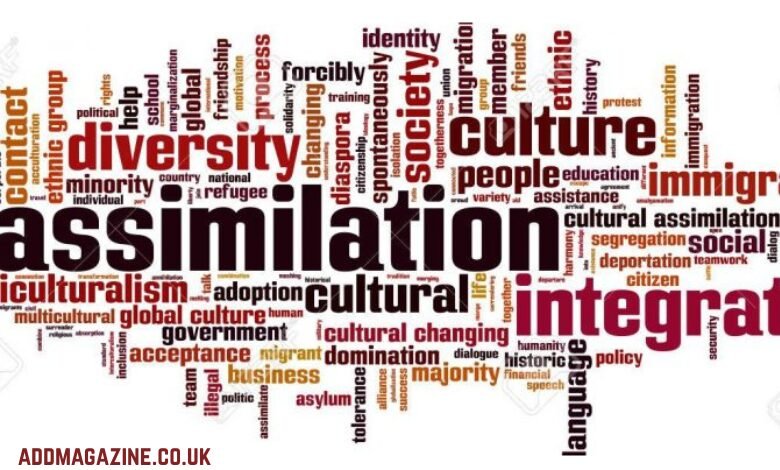Assimilasjon, or assimilation, is a process in which individuals or groups from a minority culture gradually adopt the customs, values, and behaviors of a dominant culture or society. This concept is primarily discussed in sociological, anthropological, and linguistic studies. While the term is most often associated with the integration of immigrants or minority groups into a host society, assimilation can also refer to the blending of different cultures over time, resulting in the formation of a new social identity.
At its core, assimilation involves both a cultural and structural shift. Culturally, it includes adopting the language, traditions, and social norms of the majority group. Structurally, it can mean integrating into the institutions, systems, and social networks of the dominant society.
The Process of Assimilation
The process of assimilation is complex and multifaceted. It is not something that happens overnight but rather occurs over a prolonged period, with varying degrees of success and challenges. There are several stages and factors involved in assimilation, including:
1. Initial Contact
The first stage of assimilation typically begins with the arrival of a new group into an established society. This could be due to migration, colonization, or forced displacement. In this stage, individuals from the minority group may face immediate challenges in terms of language barriers, unfamiliar cultural practices, and possible social exclusion.
2. Cultural Adaptation
As individuals from minority groups begin to interact with the dominant culture, they may start to adopt some of its customs, practices, and values. This can include learning the language, adopting clothing styles, participating in local traditions, and understanding the societal expectations of the majority group. This process of cultural adaptation is often gradual, as people learn and integrate aspects of the dominant culture.
3. Structural Integration
This phase involves the minority group becoming more integrated into the societal structures of the dominant culture. This could include accessing education, employment opportunities, housing, and political participation. Over time, individuals from the minority group may attain positions of power and influence within the society.
4. Social and Psychological Integration
Beyond the external changes that come with cultural and structural adaptation, assimilation also involves social and psychological integration. People from minority groups may begin to form social networks with the majority group and experience changes in their personal identity. This can lead to a shift in self-perception, as individuals may begin to see themselves as part of the broader national or cultural identity.
5. Full Assimilation
The final stage of assimilation occurs when individuals or groups from minority cultures are fully integrated into the dominant society. This is often marked by a disappearance of distinct cultural boundaries between groups, with individuals fully adopting the language, values, and practices of the host society. However, full assimilation is rare, as many individuals and groups maintain certain aspects of their original culture while still integrating into the mainstream society.
Types of Assimilation
Assimilation does not always follow a uniform or linear pattern. Different types of assimilation can occur, depending on the context and the individuals involved:
- Cultural Assimilation: This is when a minority group adopts the customs, practices, and lifestyle of the dominant culture. Cultural assimilation may include adopting the language, religious practices, dress code, and food habits of the majority society.
- Linguistic Assimilation: This type of assimilation happens when individuals or groups from a minority language background adopt the language of the majority group. This is often seen in immigrant populations where learning the dominant language is necessary for economic and social mobility.
- Structural Assimilation: This occurs when the minority group gains access to and participates in the political, economic, and educational systems of the dominant society. Structural assimilation can involve moving beyond ethnic enclaves and fully engaging with mainstream institutions.
- Psychological Assimilation: This type refers to the internal process where individuals begin to adopt the values, attitudes, and worldview of the dominant group. This psychological integration can influence one’s self-identity and attitudes toward others.
The Roots of Assimilasjon
The concept of assimilation has historical roots in both colonial and post-colonial contexts. Assimilation was often used as a tool by colonial powers to force indigenous peoples and immigrants to adopt the colonizers’ cultural norms, languages, and social structures. However, assimilation is not solely a product of colonialism; it is also a concept that emerged in the context of the development of nation-states.
1. Colonial Assimilation
During the colonial era, European powers often saw the assimilation of indigenous populations as a means of exerting control. Indigenous people were expected to adopt European languages, Christianity, and cultural practices in exchange for “civilization” and “progress.” This form of assimilation was often forceful and involved the suppression of local customs, languages, and identities.
In many former colonies, the process of assimilation left deep scars in the form of cultural loss, language extinction, and social marginalization. However, it also led to the development of hybrid cultural identities, where elements of the colonizers’ culture and the indigenous culture blended together.
2. Assimilation in Nation-Building
In the context of nation-building, particularly in the 19th and 20th centuries, assimilation was often promoted as a way to unify diverse populations within a single state. In this context, assimilation aimed to create a common national identity, especially in newly formed or expanding nation-states. It was believed that a unified culture and language were necessary for the success of the nation. This type of assimilation often focused on linguistic and cultural homogeneity.
For example, in countries like the United States, the concept of the “melting pot” promoted the idea that immigrants should assimilate into American culture and adopt English as the national language. The assimilation model emphasized that the success of the nation depended on the merging of diverse ethnic groups into one unified American identity.
Criticism and Challenges of Assimilasjon
While assimilation has often been seen as a means of fostering unity, it has been widely criticized for its potential to erase cultural diversity and lead to the marginalization of minority groups. Critics argue that assimilation can be a one-sided process where the minority group is expected to conform to the values and norms of the majority, without the opportunity to maintain and celebrate their own culture.
Some of the key criticisms of assimilation include:
- Loss of Cultural Identity: Assimilation can lead to the erosion of cultural traditions, languages, and customs that are important to minority groups. This loss of cultural heritage can create a sense of alienation and identity crises among individuals who are caught between two cultures.
- Social Exclusion: In many cases, assimilation does not result in true equality. Instead, it may lead to the social exclusion of those who are unable or unwilling to fully adopt the dominant culture. This can create feelings of resentment, social isolation, and marginalization.
- Resistance to Assimilation: Many minority groups resist full assimilation, preferring to maintain their cultural distinctiveness. This resistance can be a form of cultural pride and an assertion of autonomy. Some groups argue that their cultural identity should be valued and respected, rather than erased in the name of integration.
Modern Perspectives on Assimilasjon
In contemporary society, the idea of assimilation has evolved. Many modern scholars and sociologists argue for a more inclusive and multicultural approach, where cultural diversity is embraced, and assimilation is not forced or expected. Instead of demanding that minority groups fully adopt the dominant culture, contemporary ideas of integration focus on cultural pluralism, where different cultures coexist while maintaining their distinctiveness.
For example, countries like Canada and Australia promote policies of multiculturalism, where cultural diversity is seen as a strength rather than a challenge. These countries encourage immigrants to maintain their cultural practices while also integrating into the broader society. This approach allows for a more balanced view of assimilation, one that does not force the erasure of minority cultures.
Conclusion
Assimilasjon, or assimilation, is a complex and often controversial process of integration where minority groups adopt the language, culture, and social norms of a dominant society. The process can involve cultural, linguistic, and structural changes, as well as psychological shifts in identity. The roots of assimilation are deeply embedded in colonial history and nation-building efforts. While assimilation has been criticized for leading to cultural erasure and social exclusion, modern perspectives on integration emphasize the value of multiculturalism and cultural diversity.
In an increasingly globalized world, the debate over assimilation continues to evolve. The challenge lies in finding a balance between integration and the preservation of cultural diversity, ensuring that all individuals have the opportunity to maintain their identity while contributing to the broader society.




